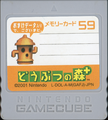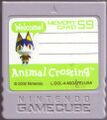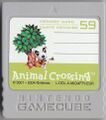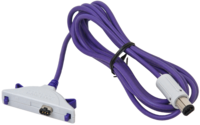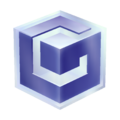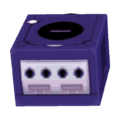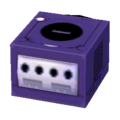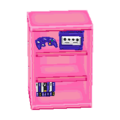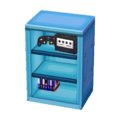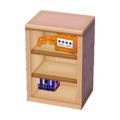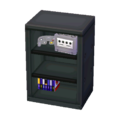Difference between revisions of "Nintendo GameCube"
PanchamBro (talk | contribs) |
AlexBot2004 (talk | contribs) (→Memory Card: Expanding) |
||
| (10 intermediate revisions by 8 users not shown) | |||
| Line 15: | Line 15: | ||
| released = {{Flag|JPN}} September 14, 2001<br>{{Flag|USA}} November 18, 2001<br>{{Flag|EUR}} May 3, 2002<br>{{Flag|AUS}} May 17, 2002 | | released = {{Flag|JPN}} September 14, 2001<br>{{Flag|USA}} November 18, 2001<br>{{Flag|EUR}} May 3, 2002<br>{{Flag|AUS}} May 17, 2002 | ||
| media = GameCube Game Disc, Game Pak <small>({{wp|Game Boy Player}} required)</small> | | media = GameCube Game Disc, Game Pak <small>({{wp|Game Boy Player}} required)</small> | ||
| − | | input = | + | | input = GameCube Controller<br>WaveBird Controller<br>Game Boy Advance |
| predecessor = [[Nintendo 64]] | | predecessor = [[Nintendo 64]] | ||
| successor = [[Wii]] | | successor = [[Wii]] | ||
| Line 21: | Line 21: | ||
The '''Nintendo GameCube'''{{Note|{{Nihongo foot|ニンテンドーゲームキューブ|Nintendou Geimukyuubu}}}} (officially abbreviated as '''GCN''') is a home video game console created by [[Nintendo]] and released in 2001. It is the successor to the [[Nintendo 64]] and the predecessor to the [[Wii]]. Three of the [[First generation|first-generation ''Animal Crossing'' games]]—{{DnM+}}, {{PG}}, and {{DnMe+}}—were released on the GameCube in 2001, 2002, and 2003, respectively. Additionally, {{SSBM}}, which features three trophies of characters from {{DnM}}, was released for the console shortly before {{DnM+|nolink}} in 2001. The GameCube has the ability to connect to the [[Game Boy Advance]] to unlock features in various games, including all three ''Animal Crossing'' games. | The '''Nintendo GameCube'''{{Note|{{Nihongo foot|ニンテンドーゲームキューブ|Nintendou Geimukyuubu}}}} (officially abbreviated as '''GCN''') is a home video game console created by [[Nintendo]] and released in 2001. It is the successor to the [[Nintendo 64]] and the predecessor to the [[Wii]]. Three of the [[First generation|first-generation ''Animal Crossing'' games]]—{{DnM+}}, {{PG}}, and {{DnMe+}}—were released on the GameCube in 2001, 2002, and 2003, respectively. Additionally, {{SSBM}}, which features three trophies of characters from {{DnM}}, was released for the console shortly before {{DnM+|nolink}} in 2001. The GameCube has the ability to connect to the [[Game Boy Advance]] to unlock features in various games, including all three ''Animal Crossing'' games. | ||
| − | The GameCube sold 21.74 million units worldwide and was discontinued in mid-2007. The GameCube's games and controllers are also backward-compatible with | + | The GameCube sold 21.74 million units worldwide and was discontinued in mid-2007. The GameCube's games and controllers are also backward-compatible with its successor, the Wii, although this feature was removed in later Wii models. |
==''Animal Crossing''-related games== | ==''Animal Crossing''-related games== | ||
| Line 42: | Line 42: | ||
==Memory Card== | ==Memory Card== | ||
:''"Memory Card" redirects here. For the similar accessory for the Nintendo 64, see [[Nintendo 64#Controller Pak|Nintendo 64 § Controller Pak]].'' | :''"Memory Card" redirects here. For the similar accessory for the Nintendo 64, see [[Nintendo 64#Controller Pak|Nintendo 64 § Controller Pak]].'' | ||
| − | + | Save data for GameCube games is stored on Memory Cards. There are three official Memory Card capacities: a gray 59-block card, a black 251-block card, and a white 1019-block card. A 59-block Memory Card featuring a unique label and special [[letter]] data was included with all copies of {{DnM+}} and {{PG}}.{{Note|In {{DnMe+}}, which was never bundled with a Memory Card, this letter is instead contained in the game itself and sent to each player upon moving into town.}} The letter on the card contains a welcome message from Nintendo and a {{I|grab bag|PG}} containing "[[K.K. Love Song]]" and two random [[NES game]]s. | |
| − | Save data for | + | |
| + | The special data, titled "Bonus Letters:1" ("Gift:1" in the European version), places the welcome letter in the mailbox of the first player to load their save, which in practice is always the first player to move to town, since the data cannot be copied or moved to a Memory Card with existing town data. After the letter is sent, the counter decrements to zero and the special data can no longer be used. | ||
| + | |||
| + | The letter reads: | ||
| + | {{Letter | ||
| + | |top=Dear <player>, | ||
| + | |line1=Welcome to Animal Crossing! | ||
| + | |line2=What we've created isn't just | ||
| + | |line3=another game, but a whole | ||
| + | |line4=new experience! Invite your | ||
| + | |line5=friends and family to join | ||
| + | |line6=you in your brand-new life! | ||
| + | |bottom=The AC Development Team | ||
| + | }} | ||
| + | |||
| + | In the European version, the welcome letter also features translations to French, German, Italian, and Spanish. | ||
| + | |||
| + | <gallery> | ||
| + | DnM+ Memory Card.png|The Memory Card included with {{DnM+|nolink}} | ||
| + | PG Memory Card NA.jpg|The Memory Card included with the North American version of {{PG|nolink}} | ||
| + | PG Memory Card NA 2.jpg|The Memory Card included with later North American Player's Choice copies of {{PG|nolink}}.<ref>{{Cite web|author=PushDustIn|date=June 6, 2016|url=https://sourcegaming.info/2016/06/06/all-about-gamecube-memory-card-variants/|title=All About GameCube Memory Card Variants|site=Source Gaming|retrieved=January 1, 2024}}</ref> This card has a black front and translucent red back. | ||
| + | PG Memory Card EU.jpg|The Memory Card included with the European version of {{PG|nolink}} | ||
| + | </gallery> | ||
==Game Boy Advance compatibility== | ==Game Boy Advance compatibility== | ||
| Line 52: | Line 74: | ||
==Appearances in the {{SER|nolink}}== | ==Appearances in the {{SER|nolink}}== | ||
| − | The | + | The GameCube has been featured and referenced several times in the {{SER|nolink}}: |
*The {{I|G logo|PG}}, which is modeled after the Nintendo GameCube logo, appears as a furniture item in {{DnM+}}, {{PG}} and {{DnMe+}}. | *The {{I|G logo|PG}}, which is modeled after the Nintendo GameCube logo, appears as a furniture item in {{DnM+}}, {{PG}} and {{DnMe+}}. | ||
*The GameCube drawer (known as the GameCube dresser in {{CF|short|nolink}}) appears as a furniture item in {{CF}} and {{NLWa}}. It it modeled after the Nintendo GameCube and serves as a [[storage unit]]. | *The GameCube drawer (known as the GameCube dresser in {{CF|short|nolink}}) appears as a furniture item in {{CF}} and {{NLWa}}. It it modeled after the Nintendo GameCube and serves as a [[storage unit]]. | ||
*The {{I|Nintendo GameCube|PC}} furniture item appears in {{PC}}. | *The {{I|Nintendo GameCube|PC}} furniture item appears in {{PC}}. | ||
| − | *The | + | *The GameCube makes a cameo in {{WW}}, {{CF}}, and {{NL}}. It appears in the game shelf (known as the pink box prior to {{NL|short|nolink}}) furniture item alongside a controller and game. In {{NL|nolink}}, [[furniture customization|customizing]] the game shelf produces the four different types of GameCube color variations released during its lifetime. |
*In {{PG|nolink}}, [[villager]]s (especially [[peppy]] villagers) may sometimes mention the Nintendo GameCube–Game Boy Advance link cable and its function, and will tell the player that they wish they had one. | *In {{PG|nolink}}, [[villager]]s (especially [[peppy]] villagers) may sometimes mention the Nintendo GameCube–Game Boy Advance link cable and its function, and will tell the player that they wish they had one. | ||
| Line 74: | Line 96: | ||
==Notes== | ==Notes== | ||
{{Note list}} | {{Note list}} | ||
| + | |||
| + | ==References== | ||
| + | {{Reflist}} | ||
==External links== | ==External links== | ||
| Line 97: | Line 122: | ||
}} | }} | ||
| − | {{System}} | + | {{Navbox System and Peripherals}} |
Latest revision as of 18:09, January 11, 2024
|
| |||||||||||||
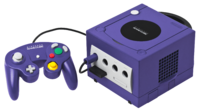 | |||||||||||||
Available colors:
| |||||||||||||
| Manufacturer | Nintendo | ||||||||||||
|---|---|---|---|---|---|---|---|---|---|---|---|---|---|
| Type | Home console | ||||||||||||
| Release date(s) | |||||||||||||
| Media | GameCube Game Disc, Game Pak (Game Boy Player required) | ||||||||||||
| Input | GameCube Controller WaveBird Controller Game Boy Advance | ||||||||||||
| Predecessor | Nintendo 64 | ||||||||||||
| Successor | Wii | ||||||||||||
The Nintendo GameCube[nb 1] (officially abbreviated as GCN) is a home video game console created by Nintendo and released in 2001. It is the successor to the Nintendo 64 and the predecessor to the Wii. Three of the first-generation Animal Crossing games—Doubutsu no Mori+, Animal Crossing, and Doubutsu no Mori e+—were released on the GameCube in 2001, 2002, and 2003, respectively. Additionally, Super Smash Bros. Melee, which features three trophies of characters from Doubutsu no Mori, was released for the console shortly before Doubutsu no Mori+ in 2001. The GameCube has the ability to connect to the Game Boy Advance to unlock features in various games, including all three Animal Crossing games.
The GameCube sold 21.74 million units worldwide and was discontinued in mid-2007. The GameCube's games and controllers are also backward-compatible with its successor, the Wii, although this feature was removed in later Wii models.
[edit]
The following titles can also be played on the first model of the Wii through backward compatibility.
| Game | Image | Release date(s) |
|---|---|---|
| Super Smash Bros. Melee | 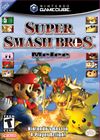 |
|
| Doubutsu no Mori+ | 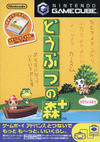 |
|
| Animal Crossing | 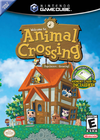 |
|
| Doubutsu no Mori e+ |  |
Memory Card[edit]
- "Memory Card" redirects here. For the similar accessory for the Nintendo 64, see Nintendo 64 § Controller Pak.
Save data for GameCube games is stored on Memory Cards. There are three official Memory Card capacities: a gray 59-block card, a black 251-block card, and a white 1019-block card. A 59-block Memory Card featuring a unique label and special letter data was included with all copies of Doubutsu no Mori+ and Animal Crossing.[nb 2] The letter on the card contains a welcome message from Nintendo and a grab bag containing "K.K. Love Song" and two random NES games.
The special data, titled "Bonus Letters:1" ("Gift:1" in the European version), places the welcome letter in the mailbox of the first player to load their save, which in practice is always the first player to move to town, since the data cannot be copied or moved to a Memory Card with existing town data. After the letter is sent, the counter decrements to zero and the special data can no longer be used.
The letter reads:
What we've created isn't just
another game, but a whole
new experience! Invite your
friends and family to join
you in your brand-new life!
The AC Development Team
In the European version, the welcome letter also features translations to French, German, Italian, and Spanish.
The Memory Card included with later North American Player's Choice copies of Animal Crossing.[1] This card has a black front and translucent red back.
Game Boy Advance compatibility[edit]
A Game Boy Advance can be connected to the GameCube via Nintendo GameCube–Game Boy Advance link cable. The GBA is used in Doubutsu no Mori+, Animal Crossing, and Doubutsu no Mori e+ to unlock extra features, most notably access to Animal Island in Doubutsu no Mori+ and Animal Crossing, and access to the Doubutsu-tachi to Asobou! minigames in Doubutsu no Mori e+.
Appearances in the Animal Crossing series[edit]
The GameCube has been featured and referenced several times in the Animal Crossing series:
- The G logo, which is modeled after the Nintendo GameCube logo, appears as a furniture item in Doubutsu no Mori+, Animal Crossing and Doubutsu no Mori e+.
- The GameCube drawer (known as the GameCube dresser in City Folk) appears as a furniture item in Animal Crossing: City Folk and Animal Crossing: New Leaf - Welcome amiibo. It it modeled after the Nintendo GameCube and serves as a storage unit.
- The Nintendo GameCube furniture item appears in Animal Crossing: Pocket Camp.
- The GameCube makes a cameo in Animal Crossing: Wild World, Animal Crossing: City Folk, and Animal Crossing: New Leaf. It appears in the game shelf (known as the pink box prior to New Leaf) furniture item alongside a controller and game. In Animal Crossing: New Leaf, customizing the game shelf produces the four different types of GameCube color variations released during its lifetime.
- In Animal Crossing, villagers (especially peppy villagers) may sometimes mention the Nintendo GameCube–Game Boy Advance link cable and its function, and will tell the player that they wish they had one.
The G logo in Animal Crossing
The GameCube dresser in City Folk
The GameCube drawer in Welcome amiibo
The Nintendo GameCube in Pocket Camp
The pink box in Wild World
The pink box in City Folk
The Pink variation of the game shelf in New Leaf, showing the Indigo GameCube
Notes[edit]
- ↑ Japanese: ニンテンドーゲームキューブ Hepburn: Nintendou Geimukyuubu
- ↑ In Doubutsu no Mori e+, which was never bundled with a Memory Card, this letter is instead contained in the game itself and sent to each player upon moving into town.
References[edit]
- ↑ PushDustIn (June 6, 2016). "All About GameCube Memory Card Variants". Source Gaming. Retrieved January 1, 2024.
External links[edit]
| Nintendo video game consoles | ||||||||||||||
|---|---|---|---|---|---|---|---|---|---|---|---|---|---|---|
| ||||||||||||||
